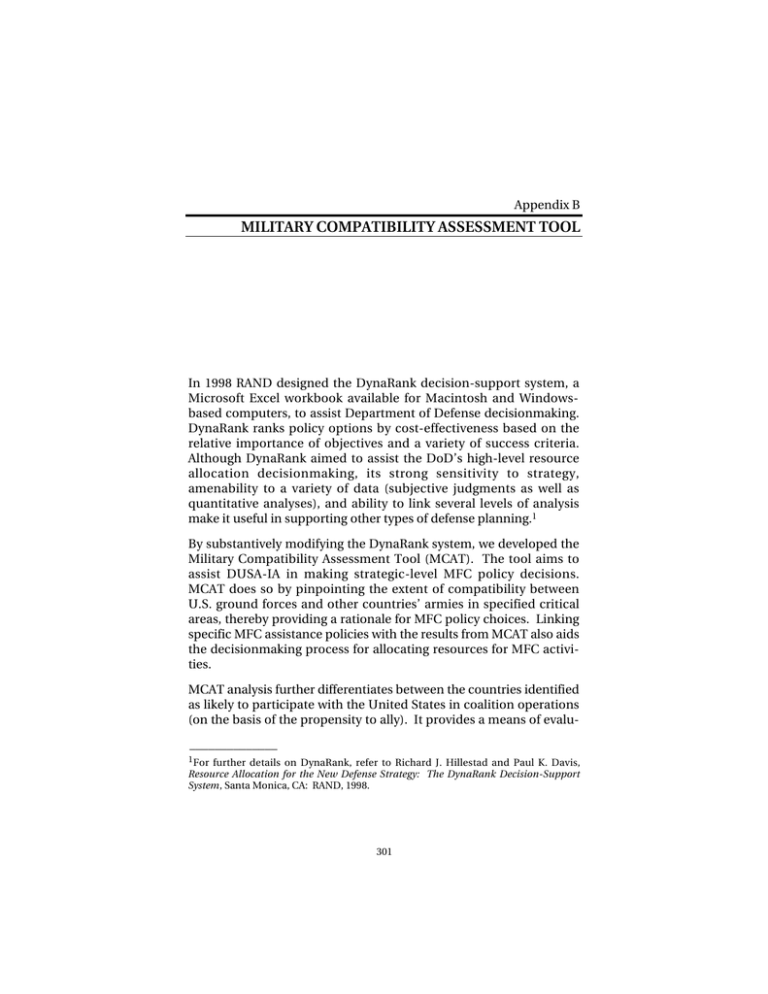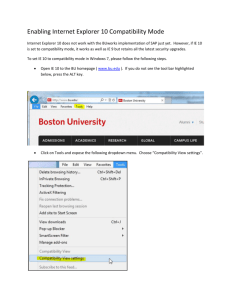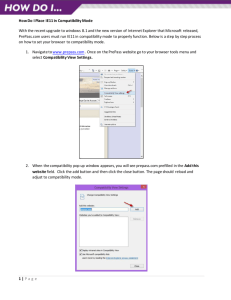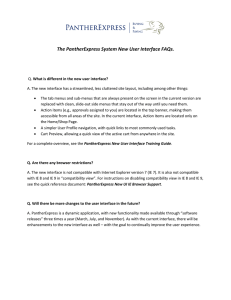MILITARY COMPATIBILITY ASSESSMENT TOOL
advertisement

Appendix B MILITARY COMPATIBILITY ASSESSMENT TOOL In 1998 RAND designed the DynaRank decision-support system, a Microsoft Excel workbook available for Macintosh and Windowsbased computers, to assist Department of Defense decisionmaking. DynaRank ranks policy options by cost-effectiveness based on the relative importance of objectives and a variety of success criteria. Although DynaRank aimed to assist the DoD’s high-level resource allocation decisionmaking, its strong sensitivity to strategy, amenability to a variety of data (subjective judgments as well as quantitative analyses), and ability to link several levels of analysis make it useful in supporting other types of defense planning.1 By substantively modifying the DynaRank system, we developed the Military Compatibility Assessment Tool (MCAT). The tool aims to assist DUSA-IA in making strategic-level MFC policy decisions. MCAT does so by pinpointing the extent of compatibility between U.S. ground forces and other countries’ armies in specified critical areas, thereby providing a rationale for MFC policy choices. Linking specific MFC assistance policies with the results from MCAT also aids the decisionmaking process for allocating resources for MFC activities. MCAT analysis further differentiates between the countries identified as likely to participate with the United States in coalition operations (on the basis of the propensity to ally). It provides a means of evalu______________ 1 For further details on DynaRank, refer to Richard J. Hillestad and Paul K. Davis, Resource Allocation for the New Defense Strategy: The DynaRank Decision-Support System, Santa Monica, CA: RAND, 1998. 301 302 Improving Army Planning for Future Multinational Coalition Operations ating the existing level of military compatibility of select foreign ground forces relative to the U.S. Army in a variety of critical mission areas. In addition, MCAT allows for variable weighting of requirements based on different missions, making the tool flexible and adaptable across the mission spectrum. An MCAT analysis produces a hierarchy of countries based on their ground forces’ compatibility with the U.S. Army and identifies both areas of greatest need and potential bottlenecks in coalition operations with the United States. It does so in a relative fashion, allowing for comparisons among the countries while judging all against the United States as the standard point of reference. The hierarchy provides input to assist DUSA-IA in making decisions about which countries and which capability assessment areas (CAAs) need attention if they are to operate more effectively in coalition operations with the United States. MCAT helps decisionmakers pinpoint the most effective policies for enhancing MFC. METHODOLOGY The MCAT provides a method for general assessment of a foreign army’s current capabilities and associated compatibility with U.S. ground forces. This flexible tool enhances the user’s ability to evaluate multiple countries based on a variety of criteria; change criterion weights according to mission requirements; and consolidate the evaluations for comparison. Initially, the user conducts an analysis of a country’s capabilities and provides an assessment (score) of the related compatibility in the designated CAAs. Once the country assessments are complete, the user opens the MCAT workbook, which consists of three worksheets: The country data worksheet; the MFC scorecard; and a scorecard functions explanation sheet. The user enters the scores onto the country data worksheet, which automatically transfer to the MFC scorecard. Utilizing the MFC scorecard, the user sets CAA weights based on mission requirements, and colors the scorecard. In the final step, the user determines the type of analysis by appropriately flagging the desired compatibility measures (CMs) for each country and then ranking the countries by effectiveness. The effectiveness ranking creates a hierarchical listing of the countries by “overall” compatibility or compatibility in any one of the three CMs. Military Compatibility Assessment Tool 303 The quality of the MCAT results depends upon the quality of the input information. The underlying country evaluations must be both credible and understandable. The evaluations, while primarily subjective, may come from specific detailed analysis, spreadsheet models or other quantitative methods, or assessments based on general and specific knowledge and experience. The sensitive nature of the information required to determine a country’s military capability and compatibility with U.S. ground forces makes consolidated data in unclassified form difficult to obtain. However, the Military Capabilities Studies, conducted for specific countries by the Defense Intelligence Agency, supply current and accurate analysis of a country’s capabilities from which to make assessments. Additional sources of information include the plans and intelligence sections of Joint, CINC, and Army staffs, CIA country studies, military attachés at U.S. embassies, and open sources such as Jane’s publications. Basic Structure of the MFC Scorecard The MCAT, an Excel-based tool, consists of two worksheets. The user enters data on the base-level worksheet for each country in nine capability assessment areas (maneuver, fire support, air defense, mobility/survivability, logistics, deployability, command and control, communications, and intelligence) evaluated by three compatibility measures (doctrine, technology, and operational readiness/ training). The data automatically transfer to the MFC scorecard, which presents the aggregate results of the assessment. Figure B.1 illustrates a completed MFC scorecard.2 The scorecard illustrates both individual and aggregate levels of information. First, the “overall row” provides a country’s overall level of compatibility in each CAA. Additionally, the aggregate column to the far right of the scorecard provides each country’s aggregate compatibility for each CM. This composite scorecard also provides a ranking of countries based on the compatibility assessment. Through a simple process of reweighting the flags located at the left of the first column, MCAT creates a hierarchical country ranking reflecting “overall compatibil______________ 2 Although all illustrations in this report are rendered in black and white, the MCAT itself utilizes a full color scheme. 304 Improving Army Planning for Future Multinational Coalition Operations RANDMR1291-B.1 BATTLEFIELD FUNCTIONS Color Blank Cells 3 CAAs High Color Value Maneuver 1 0 Fire Air Support Defense 1 1 CSS Mob/ Surv Logistics 1 1 C4I Deployability 1 C2 Commo 1 Wt or Min Intel 1 1 Low Color Value CM Compatibility Score Column Flag. COUNTRY Wt Country 1 Doctrine 1 3 3 3 2 2 2 3 2 3 2.6 Country 1 Technology 1 2 2 2 2 1 2 2 2 3 2.0 Country 1 OR/TRNG 1 2 2 2 2 1 1 2 2 2 1.8 Country 1 Overall 1 2.3 2.3 2.3 2.0 1.3 1.7 2.3 2.0 2.7 2.1 Country 2 Doctrine 1 2 2 1 1 2 1 2 2 1 1.6 Country 2 Technology 1 2 1 1 1 1 0 2 1 1 1.1 Country 2 OR/TRNG 1 2 1 1 1 1 0 2 1 1 1.1 Country 2 Overall 1 2.0 1.3 1.0 1.0 1.3 0.3 2.0 1.3 1.0 1.3 Country 3 Doctrine 1 1 1 1 1 2 2 1 2 1 1.3 Country 3 Technology 1 2 2 1 2 1 1 1 2 2 1.6 Country 3 OR/TRNG 1 1 1 1 1 1 1 1 1 1 1.0 1 1.3 1.3 1.0 1.3 1.3 1.3 1.0 1.7 1.3 1.3 Country 3 Overall Figure B.1—Completed and Unweighted MFC Scorecard ity” or compatibility by CM. Additionally, the scorecard allows a comparison of countries, not only by overall level of compatibility, or CM, but also by levels of compatibility within the individual capability assessment areas. Capability Assessment Areas (Columns) / Compatibility Measures (Rows) We derived the MCAT criteria, both CAAs and CMs, by examining multiple reports on past multinational operations and a variety of Army publications.3 While these criteria provide a valid and critical ______________ 3 Publications include Army Field Manual FM 100-5 Operations, June 1993; Army Field Manual FM 100-8, The Army in Multinational Operations, November 1997; Allied Joint Publication AJP-01(A), Allied Joint Doctrine, March 1999; Joint Task Force Military Compatibility Assessment Tool 305 examination of a country’s capability/compatibility, the strength of the MCAT lies in its ability to let the analyst change the criteria if an examination of the underlying assumptions proves they are no longer valid or require adjustment as the situation may dictate. Utility Values/Body of the MFC Scorecard MCAT does not automatically complete the large analytic task of filling out the body of the scorecard. The user must make a subjective assessment of a country’s capabilities and then relate the assessment to a compatibility score. The underlying assumption for the country analysis is that a country’s capabilities directly relate to its compatibility with U.S. ground forces and therefore provide the best method for evaluation. Differences in nations’ military capabilities lead to asymmetry between forces. This asymmetry, whether doctrinal, technological, or procedural, will complicate interoperability and hinder coordination. In evaluating these asymmetries, we classify countries in terms of compatibility. While similar capabilities often signal an increased level of compatibility between countries, we recognize that this is not always the case. Equality of capabilities between nations does not necessarily equate to compatibility between nations. For example, two countries may have the same type of equipment but use it for different missions.4 In-depth analysis of this type of asymmetry is important when making detailed decisions about individual nations. But when evaluating relative compatibility to make strategic decisions about _____________________________________________________________ Commander’s Handbook for Peace Operations, Joint Warfighting Center, February 1995; Roger H. Paulin, Multinational Military Forces: Problems and Prospects, London: Institute for Strategic Studies, Adelphi Paper 294, 1995; Thomas J. Marshall (ed.), with Phillip Kaiser and Jon Kessmeire, Problems and Solutions in Future Coalition Operations, Carlisle Barracks, PA: U.S. Army War College, Strategic Studies Institute, December 1997; Martha Maurer, Coalition Command and Control, Washington, D.C.: National Defense University, Institute for National Strategic Studies and the Center for Advanced Concepts and Technology, 1994; Michele Zanini and Jennifer Morrison Taw, The Army and Multinational Force Compatibility, Santa Monica, CA: RAND, MR-1154-A, 2000; and Elwyn Harris, Stephanie Cammarata, Jody Jacobs, Lewis Jamison, Iris Kameny, and Paul Steinberg, unpublished RAND research, 1998. 4 The concept of asymmetry is taken from Chapter 3 (by Steven Metz) of Problems and Solutions in Future Coalition Operations, op. cit. 306 Improving Army Planning for Future Multinational Coalition Operations MFC policies, the concept can be simplified, allowing for crosscomparisons between nations. We assume that a foreign army with more advanced capabilities in a particular CAA has a higher level of compatibility with U.S. ground forces relative to a country with little or no capability in that CAA. Countries with similar equipment and doctrine will have a higher compatibility level than countries with dissimilar equipment or doctrine. This assumption allows us to make subjective judgments on compatibility and cross-comparisons between nations. The aforementioned reasoning led to the development of four levels of compatibility. The compatibility measures range from “No Capability—0” to “High Capability—3.” Figure B.2 presents both the levels of compatibility and the weighting scheme used on the MFC scorecard.5 Note that the definitions for levels 1 and 2 (light and dark gray) derive from the ability to increase compatibility either through long-term fixes (light gray) or short-term fixes and workarounds (dark gray). A 2000 RAND study on MFC, entitled The Army and Multinational Force Compatibility, derived the following definitions to explain long- and short-term fixes. Broadly defined, short-term fixes or workarounds represent those steps taken prior to a deployment, once it becomes a distinct possibility (i.e., during the planning phases of an operation). Long-term fixes equal long-term solutions sustained across operations. 0 No capability (no compatibility) 1 Low capability (long-term fixes required for compatibility) 2 Medium capability (short-term fixes and workarounds will ensure compatibility) 3 High capability (highly compatible/mission ready) Figure B.2—Compatibility Levels ______________ 5 Although all illustrations in this report are rendered in black and white, the MCAT itself utilizes a full color scheme. Military Compatibility Assessment Tool 307 Weighting of Capability Assessment Areas MCAT allows for varying the relative weights of the CAAs. In its default setting, MCAT places a weight factor of 1 on each CAA. Equal weights on all categories generate a cumulative score for each row that is a simple average of each individual value. We would recommend starting the analysis with the default setting, since this establishes a useful baseline estimate of how the countries compare across a number of factors. The weights can be changed when the user is considering scenarios in which it is clear that a particular CAA (or set of CAAs) is either more or less relevant than others. For instance, if countries are assessed on their compatibility for operations with long lead times (such as another Gulf War, when the United States and its allies had several months to deploy), one could discount the importance of prompt deployability. At the extreme, the deployability CAA could be given a score of zero, implying that each country’s score in this area would not count at all in the computation of the row compatibility score. Dropping deployability from the overall score will increase the average score for countries scoring low in this CAA (the opposite applies to countries with a high deployability score).6 Other scenario variables that are likely to change the weighting scheme would include the intensity of conflict, command arrangements, and degree of involvement the United States would wish to have. While weighting of CAAs provides a useful method of evaluating MFC across different mission types, it is subjective, and the user must understand the limitations of reweighting the CAAs. A host of results can be obtained by manipulating the weights. Therefore, adjusting the weights of the CAAs is more apt to facilitate the finding of robust options among the many different alternatives for MFC funding than to ensure that the “correct” options are highlighted. ______________ 6 The effect is likely to be small if only one CAA is completely discounted. This is due to the fact that the original average score includes eight other CAAs and is therefore relatively insensitive to the removal of one out of nine inputs. 308 Improving Army Planning for Future Multinational Coalition Operations Table B.1 Framework for Deriving Mitigation Measures Ad Hoc, High or Low Intensity, Long Lead Time Problems C4I Logistics and Deployability Doctrine, Procedures and Employment Operational Provide C4I, liaisons; IMET, predeployment MTTs; develop intelsharing protocols Organizational Establish lead nation C2 structure, geographic separation; set up C3IC Technological Loan/share/sell equipment; rely on lowest common denominator (LDC), COTS, SATCOM where not compromised Operational Phase deployment; provide logistics & lift; preposition materiel; lease lift, local transportation Organizational Establish geographic separation; stovepiping Technological Loan/share/sell equipment Operational Provide liaisons; IMET; predeployment MTTs, standardized and predeployment exercises; invite LNOs to TRADOC, War College, other Army centers; provide missing capabilities (force protection); establish a quick reaction force Organizational Establish lead nation C2 structure, geographic separation Technological Loan/share/sell equipment; rely on COTS *The fixes are shown in boldface type. The relative importance of fixes and workarounds changes with the amount of lead time: with short lead times, fixes become more important since some workarounds may not be feasible. Military Compatibility Assessment Tool 309 Table B.1—extended Ad Hoc, High or Low Intensity, Short Lead Time* Alliance, High or Low Intensity, Long or Short Lead Time Provide C4I, liaisons; develop intelsharing protocols Provide C4I, liaison; develop combined exercise training & intel-sharing protocols Establish lead nation C2 structure, geographic separation; set up C3IC Integrate C2 structure, forces; partly rely on geographic separation Loan/share/sell equipment; rely on LDC, COTS, SATCOM where not compromised Loan/share/sell equipment; rely on LDC, jointly develop equipment; rely on COTS, SATCOM where not compromised Phase deployment; provide logistics & lift; preposition materiel; lease local transportation Implement combined total asset visibility (TAV); provide logistics & lift; preposition materiel; lease lift (if long lead time), local transport Establish geographic separation; stovepiping Develop combined, complementary lift and logistics procedures; or stovepipe Loan/share/sell equipment Share, co-develop TAV; coordinate procurement to ensure compatibility Provide liaisons; IMET; standardized exercises; invite LNOs to TRADOC, War College, other Army centers; provide missing capabilities (force protection); establish a quick reaction force Develop combined doctrine, training, exercises, exchanges, etc.; provide missing capabilities (force protection); and compensate in combined planning Establish lead nation C2 structure, geographic separation Integrate command structure, forces; partly rely on geographic separation Loan/share/sell equipment; rely on COTS Loan/share/sell equipment; co-develop equipment and materiel; establish compatibility protocols 310 Improving Army Planning for Future Multinational Coalition Operations Flagging of Compatibility Measures To facilitate different levels of analysis, the user may employ the flagging function to determine the type of hierarchy MCAT produces. Based on the flagging, MCAT produces country rankings either by overall compatibility or by any one of the three CMs (doctrine, technology, or operational readiness). Figure C.3 in the next appendix provides an example of flagging the CMs for analysis. Linking MCAT Data to MFC Assistance Policies The previously mentioned 2000 RAND study of MFC analyzed the effects of Force XXI on MFC in future coalition operations. A close study of four major multinational operations found repeated use of certain “mitigation measures” to overcome compatibility problems between the United States and its coalition partners. Table B.1 outlines the results of the study’s findings. The study also demonstrated the value of engagement over the long term, or the advantage of fixes over workarounds. Such initiatives as combined training, multilateral command post exercises, technological research and development, doctrinal development, and intelligence-sharing protocols will be increasingly important as forces with vastly different capabilities attempt to coordinate their efforts. 7 Linking the MCAT results to this study reveals several significant policy applications. MCAT analyzes a country’s compatibility with U.S. ground forces relative to other possible coalition partners and identifies shortfalls in compatibility, categorizing them by both capability area and compatibility measure. Not only can the user identify a compatibility shortfall by its functional area, (e.g., intelligence, C2), he can further identify whether the problem is a doctrinal, technological, or operational readiness shortfall. The Zanini and Taw study provides a sample of the types of mitigation measures available to the Army to address compatibility. ______________ 7 Zanini and Taw.



